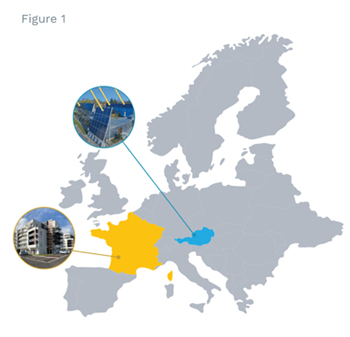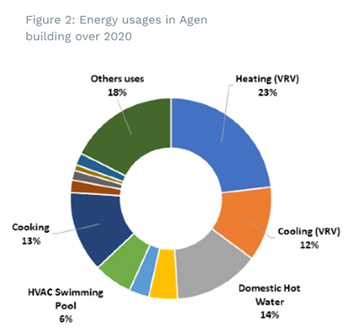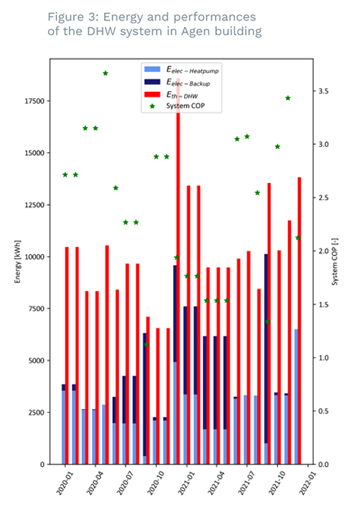About SCORES
SCORES is a collaborative research project supported by the European Commission under the Horizon 2020 Programme for Research and Innovation (Call H2020-EEB-2017). The project consortium is made up of 12 partners from 7 European countries. The overall concept of the project is based on a hybrid system effectively and efficiently combining solutions that harvest electricity and heat from the sun, store electricity, convert electricity into heat, store heat and manage energy flows in the building.
In the SCORES project, two demonstration sites were chosen – one in Austria and one in France.
A mixed usage building consisting of office space and two singlefamily homes located in Gleisdorf was chosen as a demonstration site for Austria. Its continental climate (HDD ≈ 2900°C.day) and the district heating make it representative to what can be seen in northern Europe. Space-heating and domestic hot water (DHW) are supplied by district heating, chemical loop combustion and heat pump. PV system is also installed to provide renewable electricity to the building.
The demonstration site in France is located in Agen, a warm oceanic climate (HDD ≈ 1800°C.day). It is a residential building composed of 115 apartments. It is a typical construction for France which was built recently and is compliant with the thermal regulation for buildings after 2012. The building is equipped with electric systems for space heating and DHW. Space heating is supplied by a VRV system and electric heater panels containing phase changing material for storing heat. For DHW, photovoltaic thermal (PVT) collectors coupled to waterto- water heat pumps and hot water storages are used.
A Building Energy Management System (BEMS) is also present on both demonstrators to orchestrate the operation of sub-systems and provide monitoring capabilities.
Results
The behaviour of the SCORES technologies was monitored and performances evaluated from the monitoring data collected from both sites. Monitored variables recorded with the BEMS were crucial to quantify the performances of the demonstrators by keeping track of energy flows across the system, temperature levels in thermal storages, and the level of selfconsumption of locally generated PV electricity.

Analysis was conducted in a topdown approach, assessing first energy balance at the system level, along with repartition per usages and energy carriers (Figure 1) and then assessing performances of each SCORES subsystem.
In Figure 2 one can see that, in Agen the space heating and the DHW consumption represent less than 40% of final energy for this building. The building energy efficiency is a consequence of high insulation levels, contributing to reducing spaceheating needs and losses in the distribution system.

Figure 3 illustrates the performance of the DHW system in Agen, with a system average coefficient of performances (COP) around 2.5 on average. From time to time the backup covers part of the useful energy needed mostly due to configuration issues. As it should, demonstration activities also highlighted some practical issues one must overcome when combining multiple complex systems.

Simulation Framework In addition to the demonstrators, detailed system simulations were deemed an important part in not only validating the behaviour of the demonstrators but also for evaluation of the expected performance of SCORES future system setups, where components are configured to optimise the techno-economic performance of the system. The buildings and SCORES technologies were modelled using Modelica libraries (Buildings Library as well as in-house models from AEE Intec), with yearly simulations being carried out for a wide range of system parameters including storage capacities, PV(T) areas as well as different electricity pricing tariffs such as flat tariff or day ahead. The simulated cases were coupled with the BEMS algorithm scripts which send and receive data to/from the simulation at each timestep just like in the actual demonstrator sites. Predictions are made by the BEMS regarding PV production and building consumption based on a lookup table in a weather file whereas the actual demonstrators rely on local weather forecasts to make the predictions.
Based on predictions for upcoming periods of PV surplus, the BEMS signals to charge one or more of the installed SCORES storage systems (electrical battery, PCM elements or the REDOX heat battery) with PV. The storages are then signalled to discharge on predictions of upcoming high demand such that the level of self-consumption in the building can be maximised. For scenarios with variable electricity price tariffs, the BEMS also charges the electrical battery from the grid at short notice during periods of cheap electricity and discharges during high tariff periods (Figure 4 ii). This enables the SCORES system to not only optimise for self-consumption but to also participate in the electricity market. The SCORES future system simulated cases assisted in the selection and sizing of all subsystems under the assumption that all technologies have reached a level of maturity to be scaled up and integrated into a larger system without any issues which may arise in the demos.
Furthermore, the simulation framework could serve as a virtual test environment for the interaction between the various subsystems and the BEMS algorithm itself before any commissioning of the demonstrator sites could be carried out.

Outlook
The end of the test phase should focus on assessing technical, economic, and environmental KPIs such as overall self-consumption, impact on the energy distribution system, energy expenses compared to reference installations and the impact in terms of carbon emissions.
Information:
Project ID: 766464
Funding programme: H2020
Website: www.scores-project.eu
Start date: 1 November 2017
Duration: 48 (54 months)
Project coordinator: Dr. Erwin Giling, TNO
Contact email: info@scores-project.eu
This project has received funding from the European Union's Horizon 2020 research and innovation programme under Grant Agreement No. 766464.